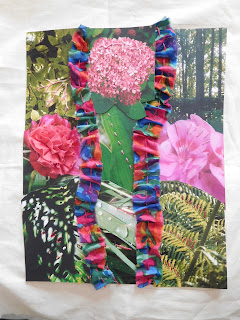Kate will now be Feb 19th with photo and fabric collage
Judith will be March 19th with chicken scratch
Please let Kate know if you plan to come along in Feb katesteane@gmail.com
Photo and fabric collage in Feb - things you can bring along
Photos –
prints, images from magazines, think about colour. Do not bring anything you
will regret cutting up (I will have more than enough photos for everyone).
Fabric –
think about the colour of your images and fabric that will merge, contrast or
otherwise work with them (if you use my photos then you would be safe to go for
greens). Think about the density of your fabric – do you want to use shears or
nets where images can be seen through them or do you want dense fabric, shiny
fabric and so on.
Cotton
embroidery threads – it is much better to secure the images with a few stitches
as glue is often rather temporary. The stitches themselves can add to the
image. Again colour is important for thread – blend or contrast.
Backing
fabric – this needs to be tough, perhaps calico or even furnishing fabric. It
does not matter what the image is as you will be covering this up (unless you
don’t want to). This fabric will hold the whole thing together – so perhaps A3
size; you will need to glue onto and stitch into this.
- Paper scissors
- Fabric scissors
- Glue stick
Kate will bring
- Her iron and towel
- A selection of translucent and transparent fabrics
- A small number of other fabrics
- A large collection of flower photos and green photos to work with if you want.

















